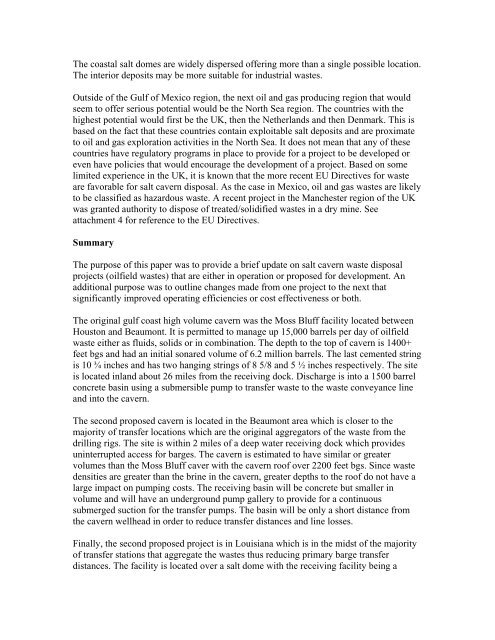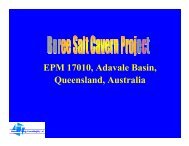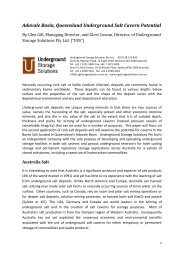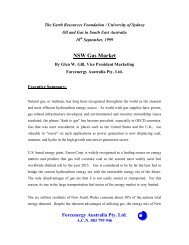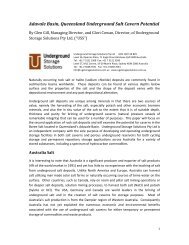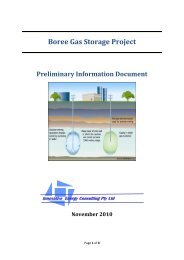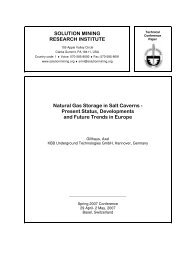Gulf Coast Waste Disposal in Salt Caverns
Gulf Coast Waste Disposal in Salt Caverns
Gulf Coast Waste Disposal in Salt Caverns
Create successful ePaper yourself
Turn your PDF publications into a flip-book with our unique Google optimized e-Paper software.
The coastal salt domes are widely dispersed offer<strong>in</strong>g more than a s<strong>in</strong>gle possible location.The <strong>in</strong>terior deposits may be more suitable for <strong>in</strong>dustrial wastes.Outside of the <strong>Gulf</strong> of Mexico region, the next oil and gas produc<strong>in</strong>g region that wouldseem to offer serious potential would be the North Sea region. The countries with thehighest potential would first be the UK, then the Netherlands and then Denmark. This isbased on the fact that these countries conta<strong>in</strong> exploitable salt deposits and are proximateto oil and gas exploration activities <strong>in</strong> the North Sea. It does not mean that any of thesecountries have regulatory programs <strong>in</strong> place to provide for a project to be developed oreven have policies that would encourage the development of a project. Based on somelimited experience <strong>in</strong> the UK, it is known that the more recent EU Directives for wasteare favorable for salt cavern disposal. As the case <strong>in</strong> Mexico, oil and gas wastes are likelyto be classified as hazardous waste. A recent project <strong>in</strong> the Manchester region of the UKwas granted authority to dispose of treated/solidified wastes <strong>in</strong> a dry m<strong>in</strong>e. Seeattachment 4 for reference to the EU Directives.SummaryThe purpose of this paper was to provide a brief update on salt cavern waste disposalprojects (oilfield wastes) that are either <strong>in</strong> operation or proposed for development. Anadditional purpose was to outl<strong>in</strong>e changes made from one project to the next thatsignificantly improved operat<strong>in</strong>g efficiencies or cost effectiveness or both.The orig<strong>in</strong>al gulf coast high volume cavern was the Moss Bluff facility located betweenHouston and Beaumont. It is permitted to manage up 15,000 barrels per day of oilfieldwaste either as fluids, solids or <strong>in</strong> comb<strong>in</strong>ation. The depth to the top of cavern is 1400+feet bgs and had an <strong>in</strong>itial sonared volume of 6.2 million barrels. The last cemented str<strong>in</strong>gis 10 ¾ <strong>in</strong>ches and has two hang<strong>in</strong>g str<strong>in</strong>gs of 8 5/8 and 5 ½ <strong>in</strong>ches respectively. The siteis located <strong>in</strong>land about 26 miles from the receiv<strong>in</strong>g dock. Discharge is <strong>in</strong>to a 1500 barrelconcrete bas<strong>in</strong> us<strong>in</strong>g a submersible pump to transfer waste to the waste conveyance l<strong>in</strong>eand <strong>in</strong>to the cavern.The second proposed cavern is located <strong>in</strong> the Beaumont area which is closer to themajority of transfer locations which are the orig<strong>in</strong>al aggregators of the waste from thedrill<strong>in</strong>g rigs. The site is with<strong>in</strong> 2 miles of a deep water receiv<strong>in</strong>g dock which providesun<strong>in</strong>terrupted access for barges. The cavern is estimated to have similar or greatervolumes than the Moss Bluff caver with the cavern roof over 2200 feet bgs. S<strong>in</strong>ce wastedensities are greater than the br<strong>in</strong>e <strong>in</strong> the cavern, greater depths to the roof do not have alarge impact on pump<strong>in</strong>g costs. The receiv<strong>in</strong>g bas<strong>in</strong> will be concrete but smaller <strong>in</strong>volume and will have an underground pump gallery to provide for a cont<strong>in</strong>uoussubmerged suction for the transfer pumps. The bas<strong>in</strong> will be only a short distance fromthe cavern wellhead <strong>in</strong> order to reduce transfer distances and l<strong>in</strong>e losses.F<strong>in</strong>ally, the second proposed project is <strong>in</strong> Louisiana which is <strong>in</strong> the midst of the majorityof transfer stations that aggregate the wastes thus reduc<strong>in</strong>g primary barge transferdistances. The facility is located over a salt dome with the receiv<strong>in</strong>g facility be<strong>in</strong>g a


